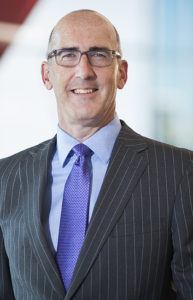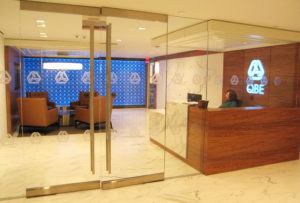If you were to ask the chief executive officer of QBE North America what success looks like, he might pull out some text messages with images of employees celebrating a recent change at the company.
Executive Summary
Putting the customer first isn’t necessarily the best way for an insurer to win business, according to QBE NA CEO Russell Johnston. Here, he explains his employee-first style of leadership and the direct impact engaged employees have on delivering for customers, producing a trickle-down effect on financial results for shareholders.The electronic high-fives for Russell Johnston came when he delivered on a promise to look into the possibility of eliminating an annoying and time-consuming task that one employee suggested might be unnecessary: filling out expense reports.
After the employee told Johnston that his prior company had a better way of tracking expenses, the leader connected with his legal team to investigate the possibility, Johnston told Carrier Management, providing an example of something he had learned during a recent employee meeting. “After a little bit of pushing and prodding and people opening their minds a little bit, we were able to change the whole process.”
“It’s a small example. It doesn’t change the world. But no one thing changes the world. If you change one thing, and then another thing, and then another thing, all of a sudden you’re living in a much better place,” he said.
 When Johnston recalled the celebratory reaction of employees, he wasn’t specifically responding to a question about how he measures success. Instead, he was describing ways in which a leader can ensure his employees are highly engaged at work and expanding on his thoughts about where his priorities are.
When Johnston recalled the celebratory reaction of employees, he wasn’t specifically responding to a question about how he measures success. Instead, he was describing ways in which a leader can ensure his employees are highly engaged at work and expanding on his thoughts about where his priorities are.
“I think a lot of companies talk about how they put the customer first, and while that sounds great from a marketing point of view, I think it misses a step. You’ve got to put the employee first.”
“If you don’t put the employee first, you can never get to the customer. If you get to the employees and they’re highly engaged, and they’re focused, and they want to do a great job when they show up for work every day, then the customer is going to feel that. And if the customer feels that, we’re going to do more business with the customer. And if we do more business with the customer, the shareholder is ultimately going to benefit,” he said.
“We put the employee at the center of everything that we do, and if we do that right, they’ll take care of the customer, and that will take care of the financial results.”
Asked what he believes are the most important qualities for a CEO to possess today, Johnston gave an answer along the same lines. “When you’re the leader of the business, your job is actually to figure out how you serve others the best way you can…There’s no way I can make every decision. It’s impossible. So, my job is to make sure that I’m serving everybody else in a way that allows them to actually go do what they have to do,” he said.
From Underwriter to Leader
Johnston said another defining quality of his leadership style—long-term thinking—has its root in his career as an underwriter, which started in 1988 as a trainee at Chubb.
“When you’re a casualty underwriter, you need to live with your decisions for a very long time. In some ways, that has oriented me not to think in six- or 12-month time horizons but to think about things over three- to five-year time horizons because my hope is that I leave this business in a better place when my successor steps into the role. If all you do is focus on what’s 30 meters in front of you, you can almost never do that.”
Why did Johnston choose a career in insurance?
“When I was getting out of school, I knew I wanted to be in a business that analyzed companies,” he said, explaining that investment banking and insurance were two choices that seemed to fit with the ambitions of the finance major. “I had great affinity, and at least a degree of familiarity, with the insurance space,” he said, referring to the fact that his father worked as a treaty reinsurance broker for two decades and that, following his father’s footsteps somewhat, he himself had completed a summer internship with Guy Carpenter while he was in school.
Chubb, he said, provided a great foundation for insurance and a great culture. “The beauty of that firm is they knew exactly what they wanted to do, and they did it really, really well,” he said, giving his assessment of the Chubb culture in those days. “But if you wanted to think a bit outside the box, that wasn’t their strategy,” he added.
That felt too restrictive for Johnston, who decided to join the team at American International Group Risk Management in New York. Johnston spent the next 25 years of his career at AIG. “It was a great run. Still, to this day, I have a lot of respect for and personal affinity for that company,” said Johnston, who confirmed that his departure wasn’t entirely voluntary but instead part of a reorganization at AIG.
“Every company goes through what it decides is right at a certain threshold. So they chose to make some changes. I happened to be having a discussion with QBE at the same time, and sometimes in life, timing is everything,” he said.

Russ Johnston’s Thoughts on Leadership
“People won’t remember that you put a candy bar on their desk on their birthday. They’re going to remember when things went wrong, how you reacted.”
“We put the employee at the center of everything that we do, and if we do that right, they’ll take care of the customer, and that will take care of the financial results.”
“When you’re the leader of the business, your job is actually to figure out how you serve others the best way you can.”
“For me, job one was let me make sure that we can go from what I’ll call a group of high-caliber individuals to a really high-performing team. How do I make sure that I get this leadership team all pulling in the same direction in a really effective way?” he said, noting that when he arrived, 70 percent of the members of the executive management board (QBE’s name for its executive team) had been there 18 months or less.
Johnston believes that in any industry, but most especially in financial services, having the right people and the right leaders—”people energized about what they do”—is a key to success. Without them, “you can have the greatest strategy in the world [and] it just doesn’t matter,” he said, going on to talk about his belief in putting employees first.
How else does Johnston ensure that he has an energized employee base?
“This is going to sound really simple, but it requires you to make sure that you’re actually focused on it [and] actually listen to employees and spend time with them. It starts with that,” he said, speaking to Carrier Management in one of several newly designed meeting areas—a quartet of comfortable chairs around a table in a quiet area with panoramic views of the East River and downtown Manhattan.

Photo by Peter Scott
Johnston revealed that the New York City team moved to the new building a few months earlier. “A lot of the design features in this facility are based on feedback from employees, and they notice it,” he said, going on to share a story about the newfangled coffee machines with touch screen displays that look more like computers than coffee delivery systems. When an office manager told Johnston that the company needed to get rid of the machines because they were breaking down all the time, the CEO told him to buy more of them instead. “The reason they’re breaking is the employees are using them so much because they love them…Embrace the reason why they’re breaking,” he said.
More formal vehicles for listening to employees are skip-level meetings that Johnston holds with a dozen or more individual-contributor-level employees once each month. “I do it because I know that sometimes the things I say get filtered. So it allows me to speak directly to them in an intimate way and vice versa…There are probably a half-dozen policies in the last year that we’ve changed, all because of those skip-level meetings that I hold with employees. Our employees have great ideas.”
“People really matter, and if you don’t create the right environment, [then] reporting lines and structure don’t really matter. What matters is behavior. If you’ve got the right people, and they’ve got the right behaviors, and you empower them, they’ll do great things,” he said, also reporting that new hires on the senior leadership team are interviewed by four or five other senior-level leaders to ensure a good cultural fit.
To Johnston, a defining aspect of culture for large, complex companies isn’t about celebrating success. It’s “how they look at failure,” he said. “We’re in a competitive market. Things are going to go wrong every so often, and you will define yourself to your employees in the culture you have when things don’t go right. How do you react?”
“If you react to it in a constructive, inquisitive, ‘how do we make the world better’ way, then that drives one culture. If you react in a ‘whose fault, why did this happen’ way, you create a very different culture,” he said. “People won’t remember that you put a candy bar on their desk on their birthday. They’re going to remember when things went wrong, how you reacted.”
In fact, just three months ago, the company had a system failure that touched a customer. “It wasn’t that it just stayed in our own backyard,” he said. “Every company goes through its IT challenges, and so we’re no different in that,” he said, noting that the extent of the failure prompted a team meeting that ended in messages of appreciation for the CEO. “You actually tried to understand the why instead of just reacting,” meeting participants told him, by his own report.
The bottom line is that culture starts at the top, Johnston said. “If you don’t set that tone as the CEO, that tone won’t manifest, or a bad tone will manifest in other parts of the organization.”

Photo by Peter Scott
Turning from failure to success, Johnston said the organization measures success in a couple of ways, first looking for high marks on employee engagement. Then we ask, “Are we going to be more relevant to our brokers and our customers three years from now than we are today?” Relevance, he said, can be measured in the number of products sold to existing policyholders or share of wallet with major trading partners.
The third measure is improving profit. “We’ve produced a sub-100 combined ratio the last two years. We want to continue on that track. That’s obviously the ultimate measure for the shareholder, but I think it’s also a measure for employees. Everybody wants to be part of the winning team, and that’s one of the definitions of winning.”
Finally, Johnston believes what will follow from all that is the instantaneous brand recognition in North America that occurs in other parts of the world.
“We know QBE.” That’s the typical reaction Johnston said he’ll get if he’s sitting in the Sydney airport and another traveler asks where he works. “In Singapore or London, it’s the same way. If we do all the other things right, that same conversation will take place here in the United States,” he said.





















 U.S. E&S Outlook No Longer Positive: AM Best
U.S. E&S Outlook No Longer Positive: AM Best  Viewpoint: Mapping Evolving Regulatory Terrain for MGAs, MGUs and Other DUAEs
Viewpoint: Mapping Evolving Regulatory Terrain for MGAs, MGUs and Other DUAEs  Unpacking a Consumer Intervenor’s Novel Idea
Unpacking a Consumer Intervenor’s Novel Idea  Bankers Readying U.S. IPOs at ‘Overwhelming’ Pace Ahead of 2026
Bankers Readying U.S. IPOs at ‘Overwhelming’ Pace Ahead of 2026 












